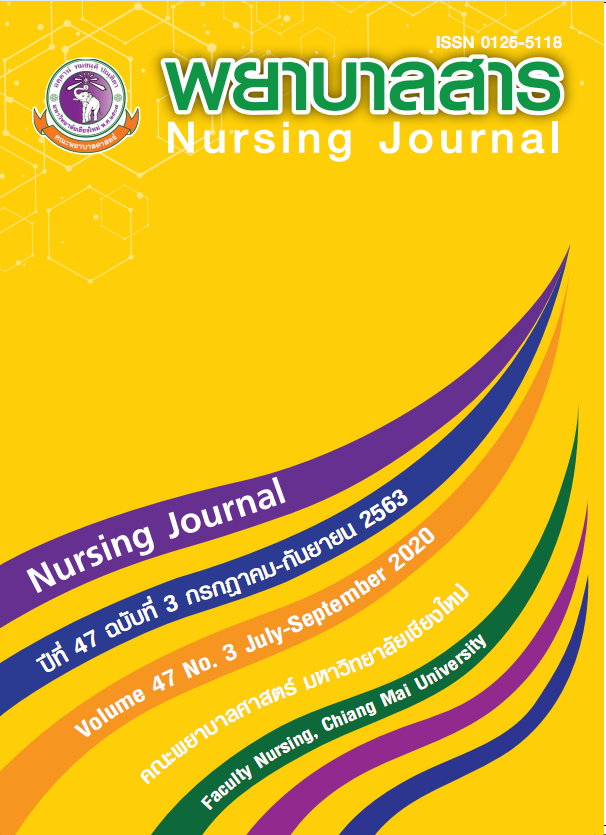Effectiveness of Self-regulation Program Among Male Adolescents in Regional Juvenile Vocational Training Centre 7, Chiang Mai Province
Keywords:
Self-regulation, Male Adolescents, Regional Juvenile Vocational Training Centre 7Abstract
Aggressive behavior is a behavior that causes both self and social problems. A self-regulation program among male adolescents increases the perception of adolescent efficacy and enables the perception of proper behavior. The purpose of this study was to examine the effectiveness of self-regulation program among male adolescents in Regional Juvenile Vocational Training Centre 7, Chiang Mai Province from April to June 2017. The participants were purposively selected and consisted of two groups including 30 male adolescents and 2 healthcare team members. The instruments used in this study were 1) a personal identification form, 2) the self-regulation program, 3) the Self-efficacy in controlling aggressive behavior scale, 4) the healthcare team satisfaction evaluation form of program implementation and 5) the male adolescents satisfaction evaluation form. Data were analyzed using descriptive statistics.
The results of this study revealed that after receiving the self-regulation program, 90% of the male adolescents had increase self-efficacy scores in controlling aggressive behavior. All healthcare team members who use the program agreed on all items relate to implementing the self-regulation program. These include relation advantage, compatibility, complexity, trialability and observability. All male adolescents participating in the self-regulation program agreed on four dimensions 1) benefit to myself, 2) benefit to their caregivers, 3) convenience to male adolescents, and 4) satisfaction with the whole program implementation.
The results of this study indicated that the male adolescents who are supervised by self-regulation program have higher self-efficacy scores for behavioral control and reduce aggressive behavior. Therefore, the self-regulation program should be implemented to continuity care at Regional juvenile vocational training centre 7, Chiang Mai province.
References
Company Limited. (In Thai)
Alee, P., Tungpunkom, P., Sripichyakan, K. (2018). Related factors of violent behavior among vocational students. Nursing Journal, 45(4), 132-143. (In Thai)
Bandura, A. (1977). Social learning theory. Englewood cliffs, NJ: Prentice-Hall.
Bandura, A. (1986). Socailfoundation of thought and action: A social cognitive theory. New
Jersey: Prentice-Hall.
Bandura, A. (1997). Self-efficacy: The exercise of control. New York: W.H. Freeman.
Booddeekhum, P. (2008). The effects of group counseling based on person- centered theory in reducing
aggressive behavior in the 9th grade students at Somdet Pariyat School Somdet District Kalasin
Province (Master’s thesis). Mahasarakham: Mahasarakham University. (In Thai)
Booneiemying, B. (2007). Buddhism psychological counseling on aggressive behavior of Fasai Wittaya
School's student. College of Religious Studies. Mahidol University. (In Thai)
Chittradub, S., & Boonsue, A. (2008). The Children’s rights education curriculum and community planning for children and youth. Bangkok: Research and development center on education for children and children with special needs, Faculty of Education, Chulalongkorn University. (In Thai)
Department of Mental Health. (2012). Guidelines for improving health systems and services for mental
health and psychiatric in central hospital, general hospital, public health service hospital, sub-district health promoting hospital. (In Thai)
Department of Juvenile Observation and Protection. (2016). Annual Statistical Report 2016, Bureau of juvenile
justice development. (In Thai)
Ministry of Public Health, Department of Disease Control, Department of Health, Department of Mental Health. (2013). Guidelines for integrated adolescent health services according to the Ministry of Public Health’s standards. Nonthaburi: The Agricultural Co-operative Federation of Thailand. LTD. (In Thai)
National Institute for Child and Family Development. (2015). The situation and conceptual framework for children and youth. Retrieved from http://www.nicfd.cf.mahidol.ac.th/th/index.php/policy/2011 (In Thai)
Ngamsri, M., Takviriyanun, N., Chapricha, S. (2013). The effect of a cognitive behavior therapy program on depression among adolescents in one juvenile training center in the north east of Thailand. Nursing Journal, 41(4), 36-47. (In Thai)
Parekitthammachai, V. (2012). The effects of behavior modification to reduce aggressive behavior of adolescents at risk (Master’s thesis). (Guidance and Counseling Psychology), Bangkok:
Graduate School, Srinakharinwirot University. (In Thai)
Pearson, A., Wiechula, R., Court, A. and Lockwood, C. (2005). The JBI model of evidence-based
healthcare. JBI Reports. 3(8), 207216. Retrieved from: http://www.kliniskeretningslinjer.dk/m
edia/343319/alan_pearson_masterclass_140913.pdf.
Rogers, E. M. (2003). Diffusion of innovations. (5th ed). New York: A Division of Imon &
Schoster, Inc Sadock B. J., Sadock V.A. (2007). Mood disorder. Philadelphia.
Senate Committee on Women, Youth and Elderly Affairs. (2007). Family violence in women and elderly.
Bangkok: The Secretariat of the Senate. (In Thai)
Srimongkontaratorn, G. (2011). Effectiveness of implementing a cognitive behavior therapy program in reducing alcohol drinking behaviors among persons with alcohol dependence, Si Satchanalai hospital, Sukhothai province (Master’s thesis). Mental Health and Psychiatric Nursing, Chiang Mai: Graduate School, Chiang Mai University. (In Thai)
Sethabouppha, H., Ratsameesuwiwat, J., Oopkam, N., Simawong, P., Thepprasong, S., & Kittiratanapaiboon, P. (2013). Effects of the KlaiBann Samanjai Program on Drinking Behaviors, Quality of Life, and Readmission among Persons with Alcohol Dependence in Southern Region, Thailand. Nursing journal, 42(1), 108-121. (In Thai)
Tabang, R. (2007). Effect of self-regulation program on self-efficacy toward aggressive behavior
controlamong adolescents (Master’s thesis). Chiang Mai: Chiang Mai University. (In
Thai)
Thai Health Promotion Foundation. (2006). Family violence in women and elderly. Bangkok:
The Secretariat of the Senate. (In Thai)
Vaayeeta, R., Chaosuansreecharoen, K.R., Chaichana, B., and Chaosuansreecharoen, P. (2014). Effectiveness of a health behavior change program on self-efficacy, self-regulation, self-care and weight loss among overweight health personal of Raman hospital, Yala province. Nursing Journal of the Ministry of Public Health, 24(2). (In Thai)
World Health Organization. (2007). Depression. Retrieved 31 December, 2010, Retrieved from
http://www.Who.int/mental_health/managenment/drepression/definition/en/.html
Young people: health risks and solutions, Fact sheet No 345 August 2011. Online. Retrieved from http://www.who.int/mediacentre/ factsheets/fs345/en/, accessed 26 March 2018.
Zimmerman, B. J. (1998). Developing self-fulfilling cycle of academic regulation: An analysis of exemplary instruction models. In Schunk, D. H. and Zimmerman, B. J. (Eds.), Self-regulated learning: From teaching to self-reflective practice (pp. 1-19). New York: Guilford.
Downloads
Published
How to Cite
Issue
Section
License
บทความที่ได้รับการตีพิมพ์เป็นลิขสิทธิ์ของวารสารพยาบาลสาร
ข้อความที่ปรากฏในบทความแต่ละเรื่องในวารสารวิชาการเล่มนี้เป็นความคิดเห็นส่วนตัวของผู้เขียนแต่ละท่านไม่เกี่ยวข้องกับมหาวิทยาลัยเชียงใหม่ และคณาจารย์ท่านอื่นๆในมหาวิทยาลัยฯ แต่อย่างใด ความรับผิดชอบองค์ประกอบทั้งหมดของบทความแต่ละเรื่องเป็นของผู้เขียนแต่ละท่าน หากมีความผิดพลาดใด ๆ ผู้เขียนแต่ละท่านจะรับผิดชอบบทความของตนเองแต่ผู้เดียว






